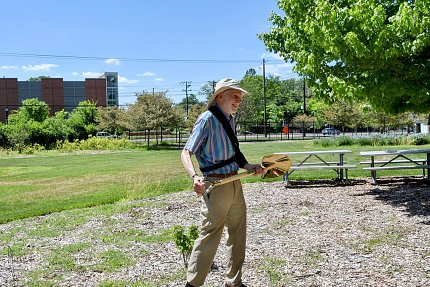New NIH Tree Honors Career of NINDS’s Fischbeck

Photo: Erin Bryant/NINDS
On May 1, the Kennedy’s Disease Association (KDA) joined with members of the Division of Intramural Research (DIR) at the National Institute of Neurological Disorders and Stroke (NINDS) to plant a tree on the NIH campus honoring the research and achievements of Dr. Kenneth “Kurt” Fischbeck, one of the nation’s leading scientists in the field of neurogenetics—the study of genetics in the nervous system.
The commemorative tree celebrates the distinguished career of Fischbeck who served as chief of the Neurogenetics Branch in the NINDS DIR from 1998 until his retirement in December 2023. Fischbeck dedicated his career to advancing the understanding and treatment of hereditary neurological and neuromuscular diseases, such as Kennedy’s disease.
Also known as spinal bulbar muscular atrophy (SBMA), Kennedy’s disease is a rare inherited neuromuscular disorder that causes muscle weakness and atrophy. Currently, there is no cure or specific treatment. Therapy is symptomatic and supportive.
“It’s fitting that it is such a beautiful day when we are commemorating the work of Kurt’s branch with something living that will take root and grow,” said Kathy Thompson, KDA corporate secretary. “This symbolizes his contributions to the KDA and Kennedy’s disease research. He has built this effort into something larger than it was when it started out.”

Photo: Erin Bryant/NINDS
Fischbeck joined NINDS in 1998 as chief of the newly formed Neurogenetics Branch. In that role, he oversaw and coordinated intramural research programs related to neurological disorders that have a genetic component. His laboratory focused on identifying the causes and studying the mechanisms of hereditary neurological and neuromuscular diseases with the goal of developing effective treatments for the disorders.
“Kurt has been with us since the beginning,” said KDA President Terry Thompson. “He has become the face of SBMA research for the KDA membership, listening to patients and their families and providing advice on their situations. He’s really great at spending the time to listen and understand the impacts of this disease on their lives.”
The sugar maple tree, which was specifically selected by Fischbeck, was planted on the side of the Porter Neuroscience Research Center (Bldg. 35) facing Old Georgetown Rd. In a few weeks, a brass plaque will be placed at the site with the inscription “In appreciation to the NINDS Neurogenetics Branch from the Kennedy’s Disease Association.”
“The location for this tree was intentional,” Terry Thompson explained. “It is adjacent to the Neurogenetics Branch lab so you can look out the window and be reminded of the great leadership Kurt provided for the past 25 years. In the spring, when the tree begins to leaf out, you can think of the promise your work is providing for so many Kennedy’s disease patients. In summer, you can take a break in the shade and reflect back on how far you’ve come in understanding this disease. And in the fall, when the tree is at its peak of brilliant color, you can think of the world-class contributions you are making towards the goal of finding a cure for this devastating disease.”
Fischbeck earned both his bachelor’s degree in biochemical sciences and his master’s degree in biology from Harvard University, and his medical degree from Johns Hopkins University. He later trained at the Case Western Reserve University Hospital in Cleveland and at the University of California, San Francisco. In 1980, he served as a research fellow in neurology at the University of Pennsylvania. Before coming to NIH, he was a professor of neurology at the University of Pennsylvania (UPenn) from 1982 to 1998. And in 1992, he served as a Boerhaave visiting professor at the University of Leiden in the Netherlands.
“Kurt’s work on Kennedy’s disease goes back even further (than NIH),” said KDA’s president. “He was lab director at UPenn in 1990 when one of his graduate students discovered the gene mutation causing the disease. Since that time, Kurt has mentored and developed SBMA researchers in many countries. He has been the major influence in the SBMA research effort around the world.”
Throughout his career, Fischbeck has received numerous awards and accolades including the Cotzias Award from the American Academy of Neurology and the Jacoby Award from the American Neurological Association. In 1999, he was elected to the Institute of Medicine of the National Academy of Sciences.
“Congratulations on your retirement, Kurt,” said Terry Thompson. “We should all meet back here when a cure for Kennedy’s disease is finally discovered.”

Photo: Erin Bryant/NINDS
